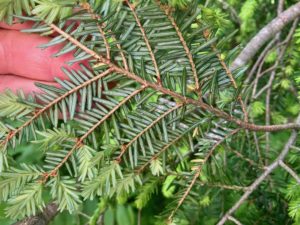Eastern Hemlock tree – 5/29/24
Observer: Paul Lauenstein
Observation Date: 5/29/24
Observation Time: 12:15 p.m.
Observation Location: High Street, Sharon
Common Name: Eastern Hemlock tree
Scientific Name: Tsuga canadensis
Comments: Hemlocks are currently threatened by the hemlock woolly adelgid (Adelges tsugae), a sap-sucking bug introduced from East Asia to the United States in 1924, and first found in the native range of eastern hemlock in the late 1960s. The adelgid has spread very rapidly in southern parts of the range once becoming established, while its expansion northward is slower, but progressing steadily as the climate warms.
Virtually all the hemlocks in the southern Appalachian Mountains have seen infestations of the insect within the last five to seven years, with thousands of hectares of stands dying within the last two to three years. Attempts to save representative examples on both public and private lands are on-going. A project named “Tsuga Search,” funded by the Great Smoky Mountains National Park, is being conducted to save the largest and tallest remaining eastern hemlocks in the Park. Through Tsuga Search, hemlocks have been found with trunk volumes up to 44.8 m³ within the park, making it the largest eastern evergreen conifer, eclipsing in volume both eastern white pine (Pinus strobus) and loblolly pine (Pinus taeda). Hemlocks are currently listed as a near threatened species in the IUCN Red List.
More Information: Wikipedia
The whitish blemishes on the underside of this hemlock frond are tiny insects called hemlock wooly adelgid, which suck the juice from the hemlock needles and, if left untreated, will eventually kill the tree.


